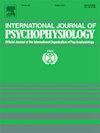N170 in attention deficit hyperactivity disorder: Systematic review
IF 2.5
3区 心理学
Q3 NEUROSCIENCES
引用次数: 0
Abstract
Background
Attention deficit hyperactivity disorder (ADHD) seems to encompass impaired emotional recognition and face processing, whose underlying mechanisms are yet to be uncovered. The N170 is an event-related potential sensitive to facial expressions, being often associated with perception and attention. Thus, this work aims to summarise and meta-analyse the literature focused on N170 modulation by ADHD.
Methods
Empirical studies measuring N170 in both ADHD and healthy individuals were identified following the Preferred Reporting Items for Systematic Reviews and Meta-analysis.
Results
Fourteen studies were included in the review. Eight studies were meta-analysed and no overall significant results were found between healthy and ADHD individuals. Moderation analysis by valence revealed no differences between groups for positive and negative valence. Neutral valence yielded more negative N170 amplitudes in ADHD than in healthy individuals.
Discussion
Altogether, findings suggest that neurophysiological processing of emotional faces is generally unimpaired in ADHD individuals. Further, it may be that ambiguous faces' processing is more demanding in individuals with ADHD. Limitations of the included studies are the variability of the tasks employed and the lacking information about the specific symptoms and medication washout. Directions for future studies are discussed.
N170在注意缺陷多动障碍中的作用:系统回顾。
背景:注意缺陷多动障碍(ADHD)似乎包括情绪识别和面部处理受损,其潜在机制尚不清楚。N170是一个对面部表情敏感的事件相关电位,通常与感知和注意力有关。因此,本研究旨在总结和荟萃分析ADHD对N170调节的相关文献。方法:根据系统评价和荟萃分析的首选报告项目,确定ADHD和健康个体中N170的实证研究。结果:本综述纳入了14项研究。对8项研究进行了荟萃分析,在健康个体和多动症个体之间没有发现总体上显著的结果。效价适度分析显示,正效价和负效价组间无差异。中性价在ADHD中比在健康个体中产生更多的负N170振幅。讨论:总的来说,研究结果表明,ADHD个体对情绪面孔的神经生理处理通常没有受损。此外,可能ADHD患者对模糊面孔的处理要求更高。纳入研究的局限性是所采用的任务的可变性以及缺乏关于具体症状和药物洗脱的信息。讨论了今后的研究方向。
本文章由计算机程序翻译,如有差异,请以英文原文为准。
求助全文
约1分钟内获得全文
求助全文
来源期刊
CiteScore
5.40
自引率
10.00%
发文量
177
审稿时长
3-8 weeks
期刊介绍:
The International Journal of Psychophysiology is the official journal of the International Organization of Psychophysiology, and provides a respected forum for the publication of high quality original contributions on all aspects of psychophysiology. The journal is interdisciplinary and aims to integrate the neurosciences and behavioral sciences. Empirical, theoretical, and review articles are encouraged in the following areas:
• Cerebral psychophysiology: including functional brain mapping and neuroimaging with Event-Related Potentials (ERPs), Positron Emission Tomography (PET), Functional Magnetic Resonance Imaging (fMRI) and Electroencephalographic studies.
• Autonomic functions: including bilateral electrodermal activity, pupillometry and blood volume changes.
• Cardiovascular Psychophysiology:including studies of blood pressure, cardiac functioning and respiration.
• Somatic psychophysiology: including muscle activity, eye movements and eye blinks.

 求助内容:
求助内容: 应助结果提醒方式:
应助结果提醒方式:


